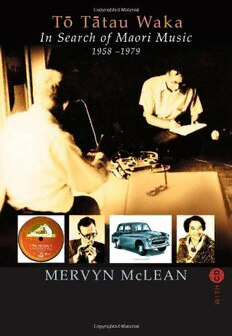
To Tatau Waka: In Search of Maori Music PDF
Preview To Tatau Waka: In Search of Maori Music
TÖ TÄTAU WAKA This page intentionally left blank TÖ TÄTAU WAKA IN SEARCH OF MAORI MUSIC (1958–1979) Mervyn McLean AUCKLAND UNIVERSITY PRESS First published 2004 Auckland University Press University of Auckland Private Bag 92019 Auckland New Zealand www.auckland.ac.nz/aup © Mervyn McLean, 2004 ISBN 1 86940 306 1 Publication is kindly assisted by the Lilburn Trust and National Library of New Zealand Cataloguing-in-Publication Data McLean, Mervyn. Tö tätau waka : in search of Mäori music, 1958-1979 / by Mervyn McLean. Includes bibliographical references and index. ISBN 1-86940-306-1 1. McLean, Mervyn. 1. Maori (New Zealand people)—Music. 3. Songs, Maori. 4. Ethnomusicology—New Zealand. 781.629944200992—dc 21 This book is copyright. Apart from fair dealing for the purpose of private study, research, criticism or review, as permitted under the Copyright Act, no part may be reproduced by any process without prior permission of the publisher. Front cover photographs: (Main picture) Recording Ira Mänihera, 1974. Peter Crowe. (Insets, left to right) Label of Nga Moteatea Song 23, sung by a Ngäti Porou group; A Hillman 80 car; the author playing a fine whale-tooth nguru from the Auckland Museum in 1970; Nini Rangimawhiti Naera Cover design: Christine Hansen Printed by Printlink Ltd, Wellington This book is dedicated to all the people whose names appear in it and all of the others who helped in so many ways This page intentionally left blank CONTENTS Getting started 1 Rotorua (May–July 1958) 13 Between times (1958–1962) 32 Getting on, and getting about 42 First 1962–64 field trip (August–October 1962) 55 Second 1962–64 field trip (February–April 1963 ) 71 Third 1962–64 field trip (August–December 1963) 91 Final 1962–64 field trip (February–May 1964) 107 PhD thesis 129 Overseas again (1965–68) 134 The later years (1969–79) 143 An appeal to Maori readers 173 Bibliography 174 Acknowledgements 177 Photo credits 178 Glossary of song types 180 Index of place names 181 Map of Tribal Distribution 183 Index of personal names 184 CD contents 188 Location of Recordings GETTING STARTED IN 1934, WHEN I WAS 4 YEARS OLD, my parents bought a portable HMV gramophone, along with a stack of 10-inch, 78 rpm records of popular songs of the 1920s and earlier such as ‘Shine on harvest moon’, ‘There oughta be a moonlight saving time’, and ‘Tiptoe thru the tulips’. I used to play these for hours, conscientiously changing the needle every two sides, and throwing the used ones down the sound box, where hundreds of them accumulated, to re-emerge many years later when the machine was overhauled for sale. Among the records were a number of early Parlophone and Columbia recordings of the Rotorua Maori Choir, with soloists such as Ana Hato and Deane Waretini, singing popular Maori songs of the day. They were special favourites of mine, and I played them over and over, astonishing my parents one day when they found me singing along, perfectly in tune they later told me, ‘words and all’. My ability with the words can be taken with a grain of salt, as my parents did not speak Maori, but these songs did acquaint me with the sound of the Maori language and I suppose got it into my head. Nothing came of it, however, for a long time. It was not until my university days, more than 20 years later, that my interest in Maori music was to be rekindled, and I began what proved to be a life’s work. The songs recorded in the 1920s by Hato and Waretini have become almost legendary. Most New Zealanders are familiar with at least some of them, such as ‘Pökarekare ana’ and ‘Pö atarau’ (Now is the Hour), or the ‘good night kiwi song’ from the days when TV closed down at An HMV portable gramophone similar to the one that kept me amused in 1934. The little swivel container in the front right corner was used for storing needles 1
